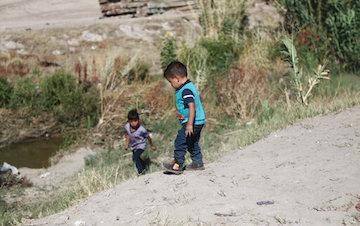
AP Photo/Christian Torres
Anita Varma is the program manager for Journalism & Media Ethics as well as Business, Leadership, and Social Sector Ethics at the Markkula Center for Applied Ethics. Views are her own.
Angie Valeria died next to her father, Óscar Alberto Martínez Ramírez. Scrolling through Twitter on Tuesday, June 25, 2019, the viral photo of their bodies facedown in the river where they drowned could, at first glance, be mistaken for a snapshot of people swimming. The captions and direct appeals of “Do Not Turn Away From This!” cued a closer look, which revealed the tragic story.
The image of Angie Valeria and her father has been likened to other iconic images in news photography, particularly the 2015 case of Syrian refugee three-year-old Alan Kurdi who also drowned. Images speak, the justification goes, and an image can change the course of history by demanding public attention beyond what words can say.
The problem with this justification for publishing images of dead children, however, is that while dominant news outlets may view publishing as doing victims justice, the outcome of these images has never been the silver bullet that journalists may wish to claim.
Far from bringing an end to the Syrian refugee crisis, in the months and years the image of Alan Kurdi’s deceased body circulated far and wide, the crisis continues to grow as a gargantuan humanitarian crisis that receives little attention, particularly in the American press following the federal government’s decision to refuse to accept even a miniscule fraction of refugees fleeing for their lives.
As quickly as major news outlets republished the image of Angie Valeria and Ramírez, they began publishing explanations for why they did so. These justifications hinged on professing commitments to informing the public, refusing to shield audiences from discomfiting truths, and arguing that it is better to tell the family’s story (with the image) since there can still be redemption through public awakening to the mortal danger that asylum-seekers face at the U.S. border
The unfortunate irony of wrenching news photographs is that even when journalists earnestly seek to urge the public to care about suffering people, consistent evidence of empathy fatigue means that readers are likely to become numb to the images – even with headlines that implore them not to turn away.
Empathy fatigue, vicarious desensitization, and empathic over-arousal are often discussed in the context of journalists returning from disaster reporting, veterans returning from active duty, and health care workers experiencing burnout from treating patients. Overlooked are the ways in which news audiences also grow fatigued, particularly when confronted with images that focus narrowly on individuals and offer no recourse or indication that the pain affecting the individuals photographed can be changed.
Empathy is a finite cognitive resource, and when depleted, social psychology literature indicates that people may begin to blame victims instead of being inclined to engage further with painful content.
Dignity for victims needs to be a chief concern when news outlets make judgments about when and how to publish images, particularly when these images are of people who are no longer alive to give their consent. There is, of course, dignity in telling someone’s story to honor their fight and insist that it not be forgotten. The indignity that journalism risks, however, is in blasting images of suffering that quickly creeps into voyeurism instead of civic engagement, and becomes fatiguing instead of galvanizing.
In contrast, news coverage of social movements like #BlackLivesMatter and #SayHerName have used the power of visual representation to evoke human suffering, but have done so in the service of a call for action. Paired with clarity around what can and should be done to address the suffering pictured, images certainly have the capacity to spark change.
If American news outlets take the stance that they have an obligation to inform their audiences, then they need to honor this obligation not only by presenting visual evidence of suffering, but also by informing audiences of how we can end this suffering – together.
